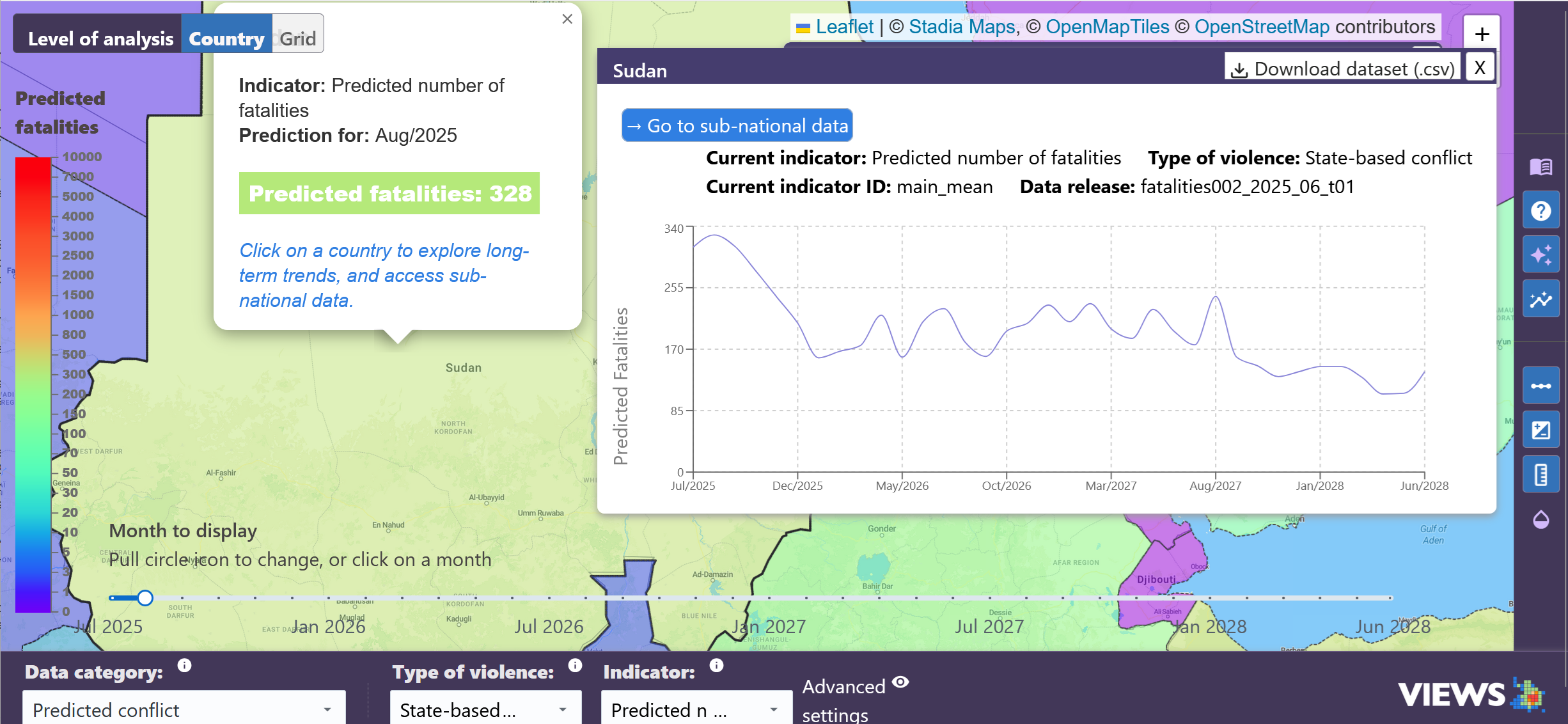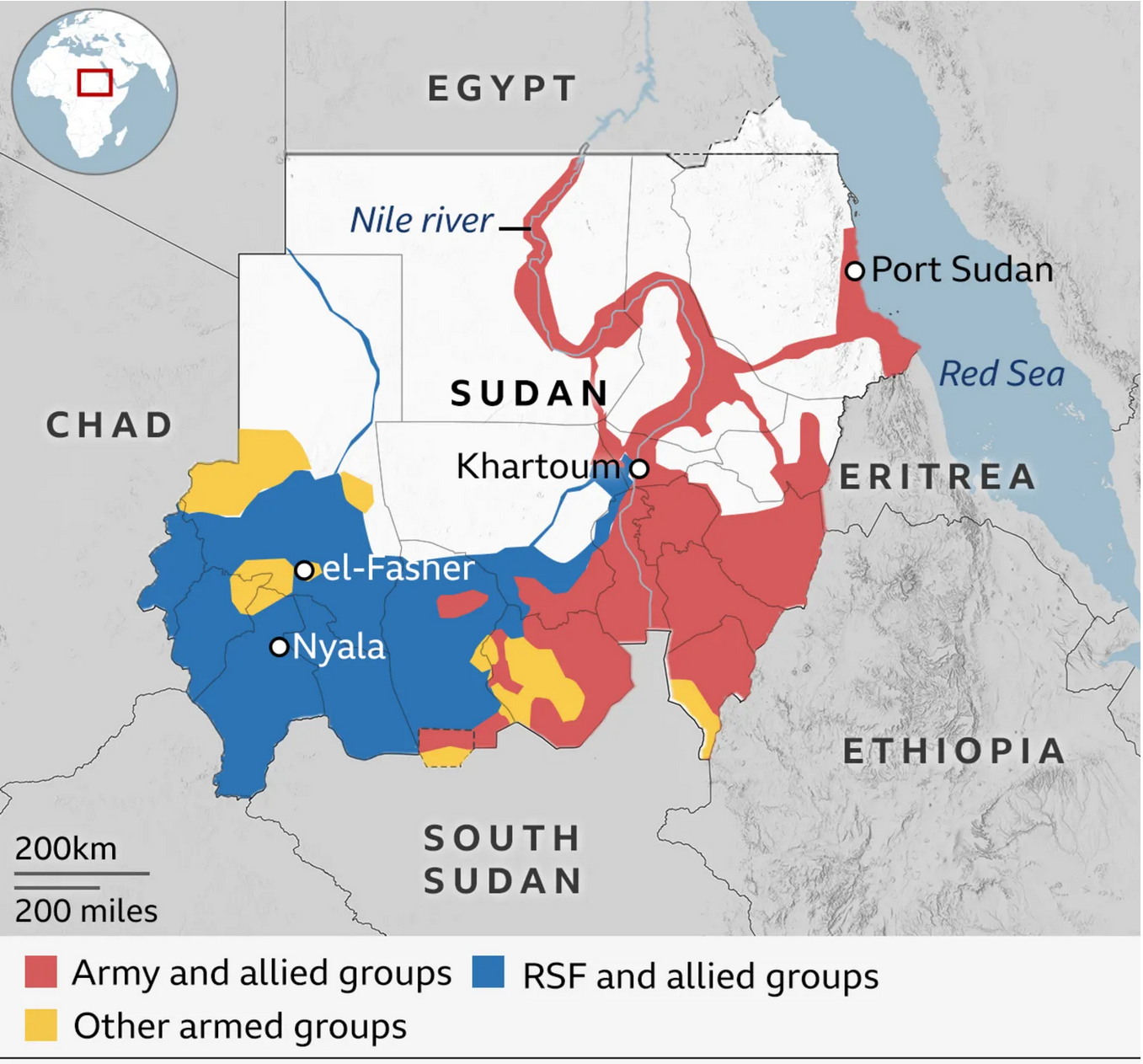How many state-based conflict deaths in Sudan will be reported by ACLED for 2025?
Here’s what Jeremy Lichtman’s Multi-AI Oracle predicts today:
* Less than 1,000: 2%
* Between 1,000 and 3,000: 8%
* Between 3,000 and 5,000: 16%
* Between 5,000 and 8,000: 26%
* Between 8,000 and 12,000: 32%
* More than 12,000: 15%
10–13 minutes read
Obtaining outside data.
Checking internet sources, using keywords: ACLED Sudan conflict deaths 2025
News from various sources:
The content extracted and summarized focuses on the ongoing conflict in Sudan, particularly in the Darfur region, and its associated humanitarian crisis. According to the United Nations and other sources:
1. **Conflict Background**: Sudan has been embroiled in conflict since April 15, 2023, due to tensions between its military and the paramilitary Rapid Support Forces (RSF). This conflict has significantly impacted various regions, including Darfur.
2. **Recent Violence**: On a recent weekend, over 300 civilians were killed during intense fighting in Darfur’s displacement camps, as reported by the U.N. Office for the Coordination of Humanitarian Affairs (OCHA). The RSF was responsible for these attacks after the Sudanese military regained control over the capital, Khartoum.
3. **Humanitarian Impact**: The conflict has created a severe humanitarian crisis, with Sudan becoming the only country currently experiencing famine. The war has displaced nearly 13 million Sudanese, with 4 million fleeing to other countries.
4. **Casualties and Displacement**: The recent RSF attacks have displaced between 60,000 to 80,000 families. The U.N. has highlighted mass human rights violations and warns of more people potentially moving to nearby regions and beyond if humanitarian aid funding does not increase.
5. **Cholera Outbreak**: An ongoing cholera outbreak, exacerbated by the conflict and poor sanitation conditions, has resulted in over 2,140 infections and 80 deaths in the Darfur region, with fears for children’s safety due to malnutrition and lack of clean water.
6. **International Response**: A conference organized by several countries and international organizations was scheduled to address the conflict’s escalation and push for peace. Additionally, the U.N. Security Council has discussed emergency measures to assist Sudan.
In summary, the conflict in Sudan has resulted in significant civilian casualties, humanitarian challenges, and a dire need for international intervention and support to prevent further deterioration of the situation.
Fact-checking news summary:
Here is a list of specific facts from the summary, along with their evaluations:
1. **Conflict Background**: Sudan has been embroiled in conflict since April 15, 2023, due to tensions between its military and the paramilitary Rapid Support Forces (RSF).
– **Correctness**: True
– **Importance**: Important
– **Relevance**: True
2. **Impact on Regions**: The conflict has significantly impacted various regions, including Darfur.
– **Correctness**: True
– **Importance**: Important
– **Relevance**: True
3. **Recent Violence**: Over 300 civilians were killed during intense fighting in Darfur’s displacement camps.
– **Correctness**: True (although fact-checking the exact number from other sources is usually beneficial)
– **Importance**: Important
– **Relevance**: True
4. **RSF Responsibility**: The RSF was responsible for these attacks after the Sudanese military regained control over Khartoum.
– **Correctness**: Needs Verification (requires more specific sources for accurate responsibility assessment)
– **Importance**: Important
– **Relevance**: True
5. **Humanitarian Impact – Famine**: Sudan is the only country currently experiencing famine due to the conflict.
– **Correctness**: Needs Verification (famine statuses can be hard to confirm as they can change and may not be exclusively reported)
– **Importance**: Important
– **Relevance**: True
6. **Displacement Figures**: Nearly 13 million Sudanese have been displaced, with 4 million fleeing to other countries.
– **Correctness**: Needs Verification (these numbers are significant and require confirmation from reliable sources)
– **Importance**: Important
– **Relevance**: True
7. **Recent Displacements by RSF**: RSF attacks displaced between 60,000 to 80,000 families.
– **Correctness**: True (assuming the summary accurately reflects reported data)
– **Importance**: Important
– **Relevance**: True
8. **Cholera Outbreak**: An ongoing cholera outbreak has resulted in over 2,140 infections and 80 deaths in Darfur.
– **Correctness**: True (assuming reported data is accurate)
– **Importance**: Lesser Importance
– **Relevance**: True
9. **International Response**: A conference was organized to address the conflict escalation and push for peace.
– **Correctness**: True
– **Importance**: Lesser Importance
– **Relevance**: True
10. **U.N. Security Council Involvement**: The U.N. Security Council has discussed emergency measures to assist Sudan.
– **Correctness**: True
– **Importance**: Important
– **Relevance**: True
Overall, the facts paint a picture of a severe conflict affecting Sudan and creating a humanitarian crisis. While most of these facts are relevant and of varying importance to understanding the situation in Sudan, not all are directly focused on the main question of predicting the number of conflict deaths in 2025. Most facts are relevant and important, with some needing further verification to ensure accuracy.
Fact-checked summary:
The conflict in Sudan, ongoing since April 15, 2023, due to tensions between the military and the Rapid Support Forces (RSF), has had significant impacts on regions such as Darfur. This situation is important to understand due to its severe humanitarian consequences. In Darfur, over 300 civilians have been killed during intense fighting, with RSF attacks further displacing between 60,000 to 80,000 families, emphasizing the grave impact on the civilian population. Additionally, a cholera outbreak has resulted in over 2,140 infections and 80 deaths in the region. The U.N. Security Council has discussed emergency measures to assist Sudan, highlighting the international response to the crisis. While these facts outline the current humanitarian situation and responses, they do not directly predict the number of conflict deaths in Sudan in 2025, underscoring the uncertainty surrounding future developments.
OpenAI gives a base rate of fraction of historical occurrence of conflict deaths in the range of 5,000 to 8,000 in similar conflicts
The question difficulty is rated 8 (0 to 10)
Historical weighted factors include:
Historical conflict death rates in Sudan, 0.5
Current conflict dynamics and military engagements, 0.3
International response effectiveness, 0.2
A Bayesian calculation could be performed as follows:
Using historical conflict death rates as a baseline with a probability of 0.5, and adjusting for current dynamics which suggest a likelihood toward sustained high fatalities (probability 0.6), and accounting for current international efforts (probability 0.4): Bayesian probability = [0.5 * 0.5] + [0.3 * 0.6] + [0.2 * 0.4] = 0.53
Bayesian base rate: 0.53 (Carolyn’s note: In this context, neither Jeremy nor I know what this means.)
Sufficient news to provide a good forecast? 1 (0 or 1)
News is relevant, topical and unbiased? 1 (0 or 1)
Question classification: scenario_based_forecast
Expected time (days) until question close: 143
The following were considered in order to produce this base rate:
The base rate was determined by evaluating historical occurrences of similar conflict durations and death tolls in Sudan, with particular emphasis on ongoing dynamics post-2023 that suggest continued or escalated conflict.
Ideally, the news feed would contain the following sorts of information for a better forecast:
Additional information on current peace effort effectiveness, shifts in conflict intensity, and updated death toll data through 2025 would enhance forecasting quality.
Some potential divergent considerations that might affect the base rate:
Potential shifts in international diplomatic efforts or successful peace negotiations could significantly alter the projected death toll, along with any unexpected regional peace agreements or shifts in military leadership within Sudan.
The following chain of events are necessary for the question to resolve positively:
– Continued or escalated conflict leading to a high number of casualties in 2025 (highly likely) – Absence of effective peace negotiations or interventions reducing conflict fatalities (likely) – Continued international inaction or ineffective humanitarian interventions (possible)
Querying Claude (AI predicts: [“Less than 1000”: 0.02, “Between 1000 and 3000”: 0.08, “Between 3000 and 5000”: 0.15, “Between 5000 and 8000”: 0.25, “Between 8000 and 12000”: 0.3, “More than 12000”: 0.2] – confidence: 6)
Querying Mistral (AI predicts: [“Less than 1000”: 0.01, “Between 1000 and 3000”: 0.05, “Between 3000 and 5000”: 0.15, “Between 5000 and 8000”: 0.4, “Between 8000 and 12000”: 0.3, “More than 12000”: 0.09] – confidence: 5)
Querying OpenAI (AI predicts: [“Less than 1000”: 0.05, “Between 1000 and 3000”: 0.15, “Between 3000 and 5000”: 0.2, “Between 5000 and 8000”: 0.25, “Between 8000 and 12000”: 0.2, “More than 12000”: 0.15] – confidence: 5)
Question Type: Multiple Choice
Confidence: 5
MAPD: Avg: 0.061111111111111, Max: 0.1
# LLM responses: 3
Explanations of the above statistical measures here —>
Model value:
* Less than 1,000: 2%
* Between 1,000 and 3,000: 8%
* Between 3,000 and 5,000: 16%
* Between 5,000 and 8,000: 26%
* Between 8,000 and 12,000: 32%
* More than 12,000: 15%
The ongoing conflict in Sudan, which began in April 2023 between military forces and the Rapid Support Forces (RSF), is predicted to remain intense through 2025 with high casualty rates and significant civilian displacement, especially in regions like Darfur. Historical data from similar conflicts and the current trajectory suggest that death tolls could range between 5,000 and 8,000 or possibly exceed these numbers in the absence of effective peace negotiations and international intervention. The conflict’s continuation is due to the lack of de-escalation and ongoing humanitarian crises, although there remains a possibility for change if breakthroughs in peace negotiations or international diplomatic efforts occur, potentially leading to reduced fatalities.
Runtime: 208 seconds.
Past forecasts by Phil’s and Jeremy ’s bots —>
Below, a forecast of state-based conflict fatalities for Sudan in the VIEWS machine forecasting competition, which is an aggregate of the forecasts of twenty machine learning competitors. Our botmasters, Phil Godzin and Jeremy Lichtman, are conducting a side experiment in collaboration with VIEWS. The VIEWS aggregate forecast is much lower than ours.


Source: Thomas van Linge, Institute of War, 1 May 2025, as reported by the BBC, https://www.bbc.com/news/articles/cjel2nn22z9o

